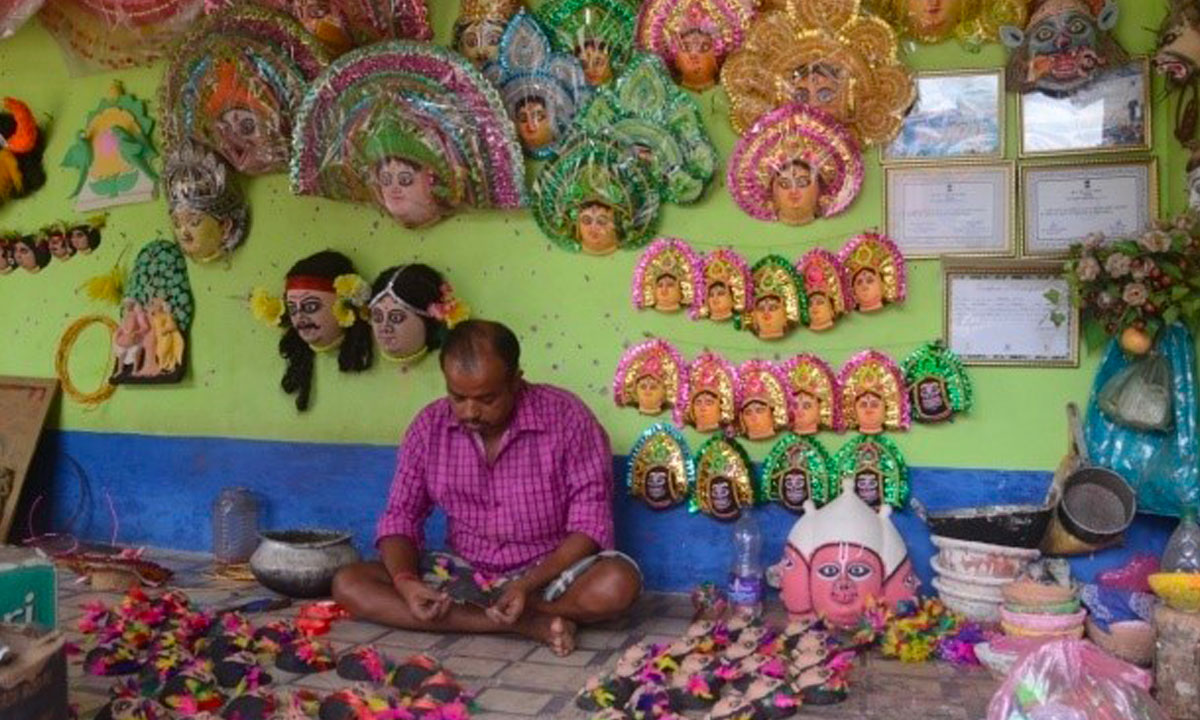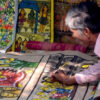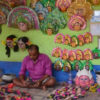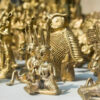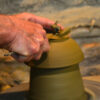© copyright of the cover image “Chau mask maker at work in Charida (2021)” belongs to Ananya Bhattacharya.
Use without the author’s permission is forbidden.
Summary
The art of Chau mask-making originated in the village of Charida in West Bengal, an eastern Indian state around 150 years ago and is now home to 115 households of traditional Chau mask-makers. The masks depicting gods, goddesses, local tribals, demons, animals, and birds are traditionally made for use in Chau dance performances, an acrobatic dance form inscribed in the UNESCO Representative List of ICH of Humanity. This practice demands skills and knowledge of sculpting techniques, painting, and a high level of creativity. Typically, masks are handcrafted using paper and cloth which are then painted – however, with the development of cultural tourism in the village, mask-makers are catering to contemporary demands for decorative masks.
This work was made possible due to the Rural Craft Hub initiative (2013-2016) of the Department of Micro Small and Medium Enterprise, Government of West Bengal in collaboration with UNESCO. It was based on the ‘Art for Life’ model of Contact Base, a UNESCO-accredited NGO in India.
The point of departure
Mask-makers were not recognized as skilled artists but were rather considered as suppliers of accessories for the Chau dance, because of which they earned a meager income during the seasonal performances. Throughout the rest of the year, they used to manage with an irregular income from labor jobs and lived in poverty.
What worked?
Through the Rural Craft Hub Project, mask-makers were first brought under the category of government-recognized skilled crafts persons and linked to various social and entrepreneurial schemes specifically meant for the development and growth of craftspeople of India. Owing to its strategic location in the foothills of Ayodhya Hills, a popular destination among tourists, outreach activities targeting hotels and transportation providers for the inclusion of the village in the regular tourism itinerary were undertaken. Consequently, capacity-building efforts for the revival, revitalization, innovation and diversification of their products eventually led to the artisans transforming their village, Charida, into a cultural tourism destination. With their participation, a community museum and gallery showcasing the history and culture of mask-makers, old traditional masks, and the process of mask-making has also been set up in the village. Additionally, Chau Mukhosh Shilpi Sangha, the Chau artists’ collective of Purulia hosts the Chau Mask Festival to attract local, national, and global visibility to their practiced art form and region. The Chau mask of Charida also received the geographical indication (GI) tag in 2018 which added to its branding and value as a cultural tourism destination.
Today, Charida is a cultural hub with a robust local industry and multiple employment opportunities for the local youth. Artists have the freedom to work from their homes as the porches double up as mask-making workshops with benches placed nearby for visitors to sit, observe the craft in action, and directly purchase the handcrafted products. Artisan families have experienced a two-fold increase in their production size and higher monthly incomes, thereby turning Chau mask-making into a primary and sustainable livelihood for the artists.
The figures
From an average of INR 5500 (US$ 74) in 2013, the monthly income per family went up to about INR 9,000 (around US $100-120) in 2018, while the average annual sales from the village amounted to INR 30 million (US$ 400,000) during the period between 2016-19. The estimated annual tourist footfall in Charida is more than 10,000, and the annual income from tourism is INR 10 million (US$ 120,000).
Challenges in developing sustainable ICH Tourism
The district of Purulia was not a popular tourist destination before 2010, but in the last decade, tourism has rapidly flourished due to the cultural offerings of the area. Charida enjoys a daily flow of visitors during tourist seasons, however, it does not mean that the positive outcomes of tourism have impacted the local community as a whole. Tourists typically visit those Chau mask-makers whose shops or workspaces are situated along the main road or in prime areas while the ones located in the interior of the village receive less touristic exposure. To tackle this issue, the government is now planning to create a market complex where the entire community’s work can be presented and sold.
Lessons Learned
The case of Charida exemplifies how tourism can support innovation and improve the viability of ICH. The development of cultural tourism has strengthened the repertoire of cultural offerings of the mask-making community.

